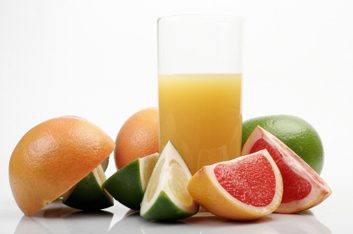The health benefits of juice
Fresh juices are liquid superfoods that are rich in nutrition and flavour

Fresh juice is packed with nutrients. As fruits and vegetables are juiced, the liquids are separated from the fibre, resulting in a concentrated blend of flavour and colour, as well as phytochemicals (protective compounds) and minerals that "are better absorbed from juice than from food that is raw but not juiced," says Vancouver-based registered dietitian Vesanto Melina, co-author of raw-food nutrition guidebook Becoming Raw.
Vegetable juices are so rich in nutrients, in fact, that while they’re no substitute for an overall balanced diet, they can help offset less-healthy diets, or even less healthy days. "When I’ve looked at how important the phytochemicals and vitamins are in protecting from chronic disease and how many people’s diets have little or none of those components, juices could help that way," says Melina.
The key? Fresh juice is best. Get yours from a juice bar or make it at home, and drink it as soon as possible (best within 15 minutes to an hour), both for nutrition and for flavour. And make sure to get a lot of variety in your juices, including fruits, vegetables, leafy greens and herbs, such as fresh parsley or ginger.
How to make great juice
"You can juice anything," says Doug McNish, executive chef at Raw Aura restaurant in Port Credit, Ont. "Start experimenting with what you like." McNish suggests aiming for vibrant colours in your juices, and gradually reducing the percentage of fruit as you get more accustomed to the flavour of vegetable and green juices. Some of his favourite blends and flavours include pear and pink grapefruit and straight carrot juice, though he makes a daily habit of a green juice blend containing kale, celery, cucumber, lemon, ginger, parsley and romaine lettuce.
One of Melina’s favourites is kale-apple-lemon’try two apples, two large leaves of curly kale and one lemon to start, then increase the quantity of kale as you get accustomed to the flavour. McNish also likes using ingredients such as sweet potatoes, pineapple and beets in his blends, and recommends a shot glass of ginger-lemon juice with cayenne to treat a cold. "Be creative," he says. And "drink lots of green juice."
As for method, the first step is to follow the instructions that come with your juicer. Besides that, McNish says he likes to follow hard or fibrous ingredients such as ginger or kale with watery ones, or to alternate. "That way the water is going to push through and get any of the extra fibrous bits out," he says.
Choosing a juicer
The number-one rule when choosing a juicer is to pick one you’ll use, says Melina. “Ease of cleaning is really quite important because you’re dragging it out all the time.” McNish agrees, and adds that he prefers masticating juicers (which grind) over juicers that use blades. Best Health tested two popular juicers to see how they really work in the home kitchen.
Breville Juice Fountain Plus
$179.99, at the Bay and other select retailers
The pros: The Juice Fountain Plus, a favourite of raw-food blogger Gena Hamshaw of choosingraw.com, is quick and easy to use, and the wide mouth means minimal prep time as many fruits and vegetables (such as beets) can be put in whole’just remove any hard pits, stems or peels. It’s also fairly quick to wash and most of the parts are dishwasher safe. Plus, the price point makes it extremely friendly to the entry-level juicer.
The cons: This is not a quiet juicer’you won’t want to run it in the morning when anyone is sleeping. And while it claims to juice leafy greens’and it does, to a certain extent’when we tried to juice kale, we ended up with a lot of unprocessed bits in the pulp container.
Hurom Slow Juicer
$359, at select online retailers including upayanaturals.com, or call 1-800-321-2226
The pros: The Slow Juicer has a small countertop footprint, and it’s quiet enough that conversations can still go on while you use it. It does a fabulous job juicing greens and can even juice wheatgrass (though we didn’t test that feature). The pulp that comes out is very dry, suggesting that as much juice as possible has been extracted.
The cons: At over $300, this machine is a big investment and perhaps not ideal if you’re not yet committed to juicing. As the name suggests, it juices slowly, and ingredients have to be chopped into smaller pieces, so the overall juicing process takes longer. Cleaning isn’t bad but does take longer than the Breville, especially if you juice stringy ingredients such as kale that can get stuck in the pulp extractor. Components aren’t dishwasher safe. This juicer isn’t yet available in Canadian retailers, although the company expects to begin distribution in spring 2011.
3 books that will get you juicing
Chef Doug McNish suggests experimenting to find juice blends you like, but sometimes a little guidance can be helpful. These books will get you on the right track.
1. The Complete Book of Juicing by Michael T. Murray
This classic guide offers details on juicing’s health benefits, plus a comprehensive listing of different ingredients and how they help certain health conditions, and an overview of juice fasting. Recipes are diverse and creative.
2. reFresh by Ruth Tal
Toronto restaurant chain Fresh started as a juice bar, and this cookbook gives full attention to juicing, with juicer recommendations, juicing tips and more than 25 juice recipes, including restaurant favourites like the Beet Root Frappé.
3. The Juicing Bible by Pat Crocker
Its 350 recipes for juices, smoothies and more, including 16 pages of colour photos, make this book an inspiring juicing resource. The ingredient guide is cross-referenced with the recipes, making it easy to work with what you have. And the ailment section suggests healing drinks to help specific conditions.




